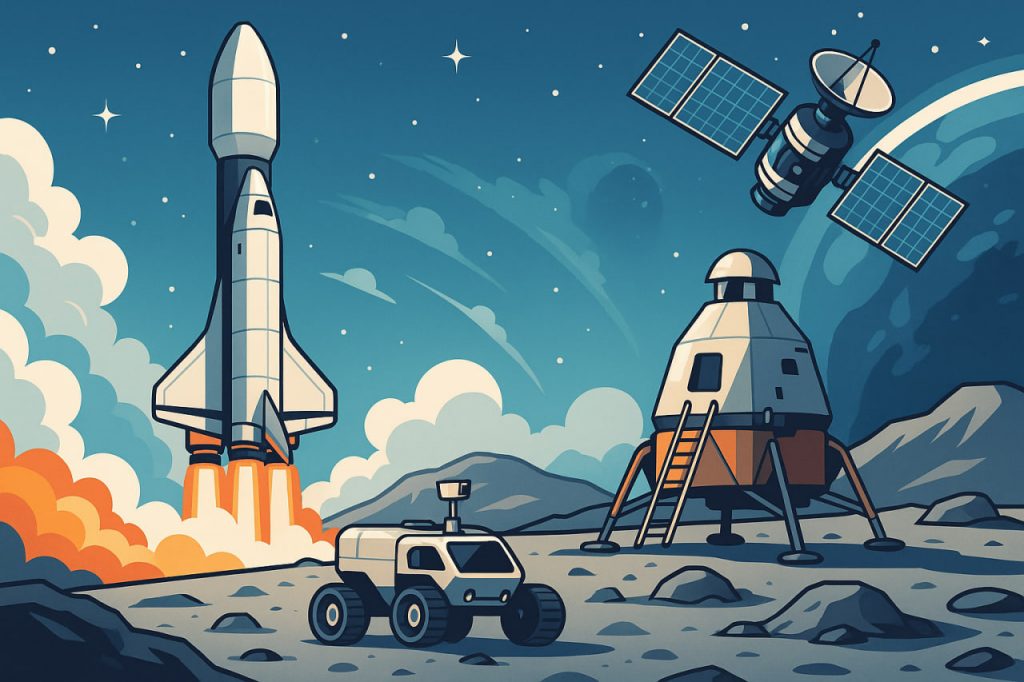We are living in a revolutionary era of space technology. Once dominated by government agencies and Cold War politics, modern space activity now includes private companies, global collaboration, robotics, and AI. From reusable rockets to lunar habitats, cutting-edge innovations are redefining what is possible in space exploration. These new technologies aim not only to return us to the Moon and reach Mars but to build a sustainable human presence beyond Earth.
Reusable Rockets: Lowering the Cost of Launch
Traditionally, rockets were single-use — expensive and wasteful. This changed with the development of reusable launch systems:
- SpaceX’s Falcon 9 and Falcon Heavy rockets can land vertically and be flown multiple times.
- Blue Origin’s New Shepard performs vertical landings for space tourism.
- Rocket Lab’s Electron is exploring mid-air booster recovery.
Reusable rockets have reduced launch costs dramatically, opening access to space for more companies and countries.
Starship and Mars Ambitions
Starship, developed by SpaceX, is a next-generation spacecraft designed for:
- Interplanetary travel, including Mars missions
- Carrying up to 100 people
- Refueling in orbit
- Heavy cargo transport
Its massive payload capacity and full reusability make it central to future colonization missions and deep-space exploration.
Satellite Megaconstellations
New space technologies are also transforming global connectivity through megaconstellations — networks of thousands of satellites in Low Earth Orbit (LEO). Notable examples:
- Starlink (SpaceX): Aims to provide high-speed internet to remote areas worldwide.
- OneWeb: A UK-based competitor also building a global network.
- Amazon’s Project Kuiper: Set to launch its own constellation soon.
These constellations are reshaping communications, navigation, and data access.
Lunar and Martian Technologies
NASA and other space agencies are developing technologies to support long-term missions on the Moon and Mars:
- Artemis Program: Aims to return humans to the Moon by the late 2020s.
- Gateway Station: A lunar orbital outpost for staging future missions.
- Habitat modules: Being designed by Axiom Space, Bigelow Aerospace, and others.
- In-Situ Resource Utilization (ISRU): Technologies that extract oxygen or water from lunar or Martian soil.
These systems are essential for building sustainable human outposts on other worlds.
Advanced Robotics and AI
Robotics and artificial intelligence now play a vital role in modern space operations:
- Perseverance rover on Mars uses autonomous navigation and sample collection.
- Robotic arms on the ISS help with repairs and satellite deployment.
- AI mission planning: Helps control spacecraft and monitor systems in real time.
These technologies reduce risk to astronauts and increase mission flexibility.
3D Printing and On-Demand Manufacturing
Additive manufacturing (3D printing) is revolutionizing how we build in space:
- Components can be printed on-site aboard the ISS or lunar bases.
- Reduces the need to launch spare parts from Earth.
- Relativity Space is building rockets with up to 90% 3D-printed parts.
This innovation allows for faster, cheaper, and more adaptable construction in orbit or on planetary surfaces.
Glossary
- Reusable rocket: A launch system that can return and fly again.
- Starship: SpaceX’s large, reusable spacecraft designed for Moon and Mars missions.
- LEO (Low Earth Orbit): A region of space within ~2,000 km of Earth’s surface.
- ISRU (In-Situ Resource Utilization): Using local resources in space for fuel, air, or water.
- Megaconstellation: A large network of satellites working together.
- Artemis Program: NASA’s initiative to return humans to the Moon.


